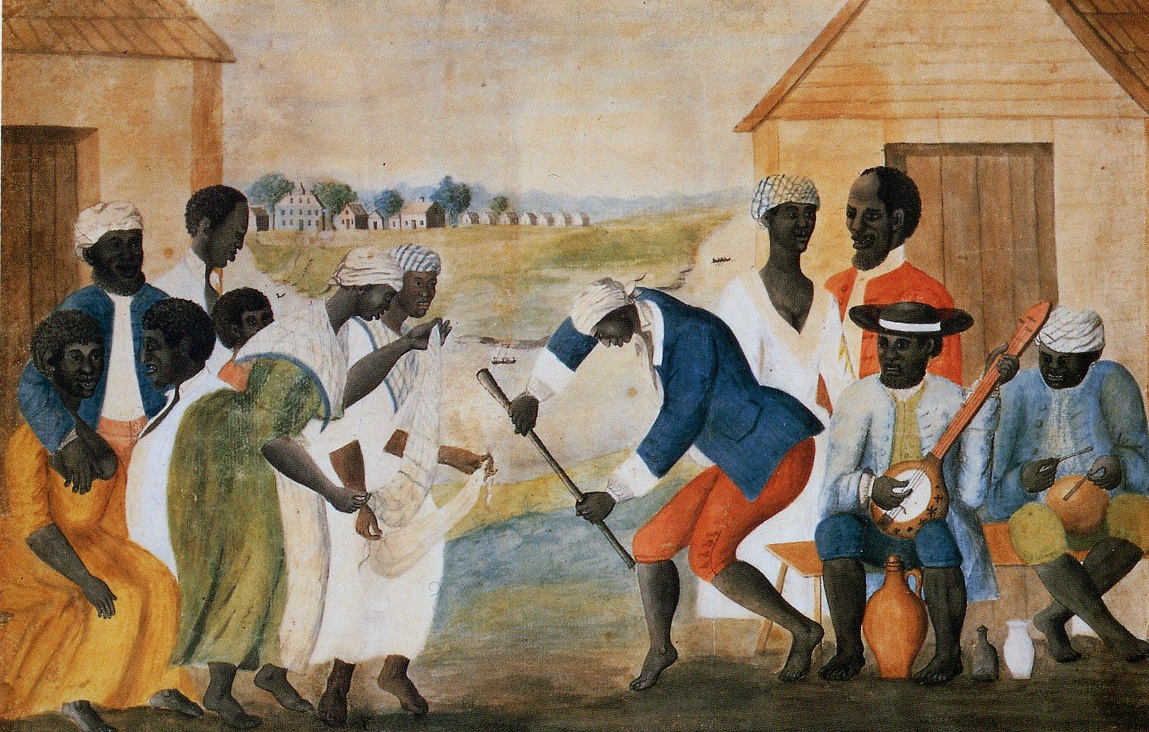- The Old Plantation
Infobox Painting

title=The Old Plantation
artist=Artist unknown
year=possibly 1790–1800
type=Watercolor onlaid paper Harvnb|Mazow|2005|p= [http://books.google.com/books?id=r6eGxpIbsqUC&pg=PT74&sig=gCL4Kge6Is0XIrFnuS1RQAq4vYQ 108] .]
height=29.7
width=45.4
height_inch= 11.7
width_inch = 17.9Harvnb|Broyles|2000|p=94.]
city=Williamsburg, Virginia ,USA
museum=Abby Aldrich Rockefeller Folk Art Center "The Old Plantation" is an American
folk art watercolor that was likely painted in the late 18th century on aSouth Carolina plantation .Harvnb|Foster|1997| p= [http://books.google.com/books?id=lmNF158DvrMC&pg=RA3-PA374&sig=rg3aZAyQ6wDj8ip9IpPFpjDbSZY 374] .] [Harvnb|Epstein|1975|p=354.] Harvnb|Epstein|1975|p=351.]The painting depicts African American slaves between two small outbuildings of a plantation on a river bend. "The Old Plantation" is the only known painting of its era that depicts African Americans by themselves, concerned only with each other,Harvnb|Bontemps|2001|p= [http://books.google.com/books?id=kAA5ehSLwTcC&pg=PA7&source=gbs_search_s&sig=2ZEen9h4Cfh4DRbw4FZ-R9NHmNw 7] .] though its central activity remains obscure. Some authorities have speculated that the painting depicts a marriage ceremony, with the attendant tradition of
jumping the broom . Other scholars have suggested that the subjects are performing a secular dance: the Yoruba ofNigeria traditionally danced barefoot with sticks and scarves, and the headdresses pictured are ofWest Africa n and perhaps distinctly Yoruban origin.The painting features two musicians, one of whom is playing a stringed instrument that resembles a Yoruba molo;Harvnb|Epstein|1963|p=202.] the body of this instrument seems to be a hollow
gourd . The molo is a precursor to the banjo, and this is the earliest known American painting to picture a banjo-like instrument. [Harvnb|Mazow|2005|p= [http://books.google.com/books?id=r6eGxpIbsqUC&pg=PA23&sig=PWUbuRvkmhAye02T5sWn8h6VK4Q 23] .] The second musician is playing a percussion instrument that may be a Yorubagudugudu ; others have suggested, however, that he is hitting sticks or bird bones against a hollow gourd.The painting was purchased for
Abby Aldrich Rockefeller from Mary E. Lyles ofColumbia, South Carolina , who said that it was painted on a plantation between Charleston and Orangeburg, South Carolina by one of her ancestors. Awatermark on the paper has been identified as that used by the EnglishpapermakerJames Whatman II (1741–1798) between 1777 and 1794. The painting was restored by art conservator Christa Gaehde in 1954–1955, who cleaned the painting, flattened creases, mended tears, filled andinpainted losses in the paper, and added awashi paper backing. The painting is currently held by theAbby Aldrich Rockefeller Folk Art Center inWilliamsburg, Virginia .References
Works cited
* Citation
last =Bontemps
first =Alex
year =2001
title =The Punished Self: Surviving Slavery in the Colonial South
publisher =Cornell University Press
isbn =0801435218.
* Citation
last =Broyles
first =Tab
year =2000
title =A Day in the Life — Episode Four: Jill's Day
publisher =Colonial Williamsburg Foundation
url =http://www.history.org/History/teaching/Dayseries/pdf_files/Episode_Four.pdf
* Citation
last =Epstein
first =Dena J.
publication-date =
date =Spring 1963
year =1963
title =Slave Music in the United States before 1860: A Survey of Sources (Part I)
periodical =Notes
series =2nd series
volume =20
issue =2
pages =195–212
issn =0027-4380
* Citation
last =Epstein
first =Dena J.
date =September 1975
year =1975
title =The Folk Banjo: A Documentary History
periodical =Ethnomusicology
volume =19
issue =3
pages =347–371
issn =0014-1836
* Citation
last =Foster
first =Helen Bradley
year =1997
title =New Raiments of Self: African American Clothing in the Antebellum South
publisher =Berg Publishers
isbn =1859731899.
* Citation
last =Mazow
first =Leo G.
year =2005
title =Picturing the Banjo
publisher =Penn State Press
isbn =027102710X.
Wikimedia Foundation. 2010.
